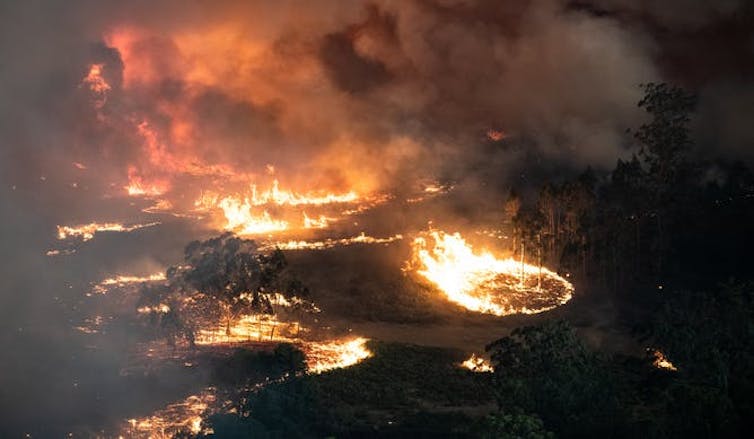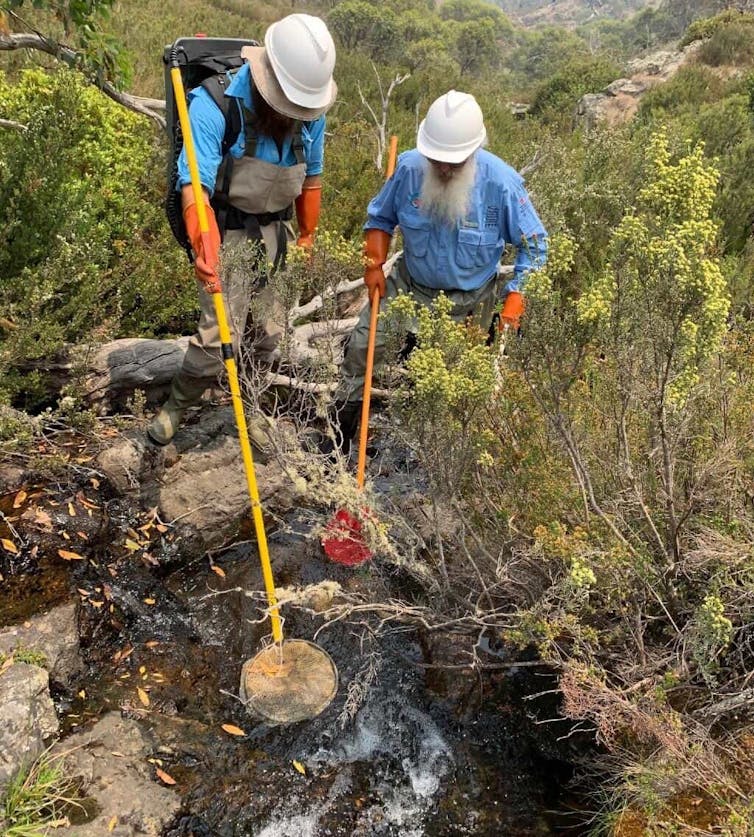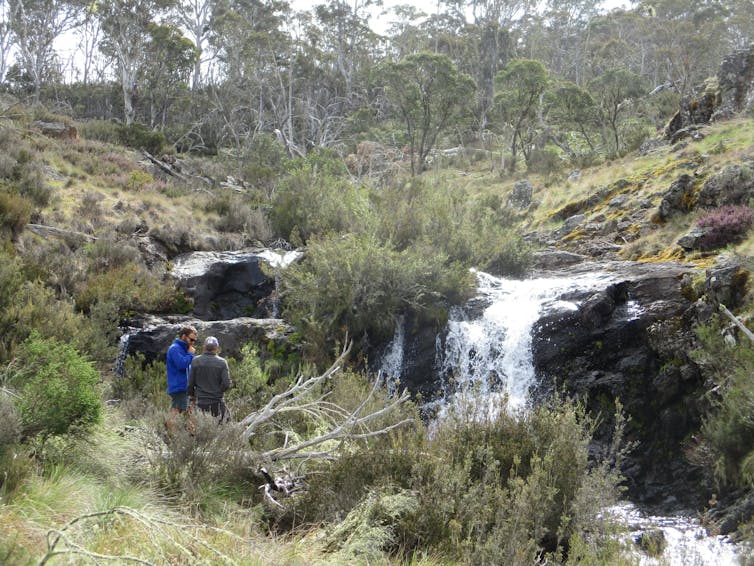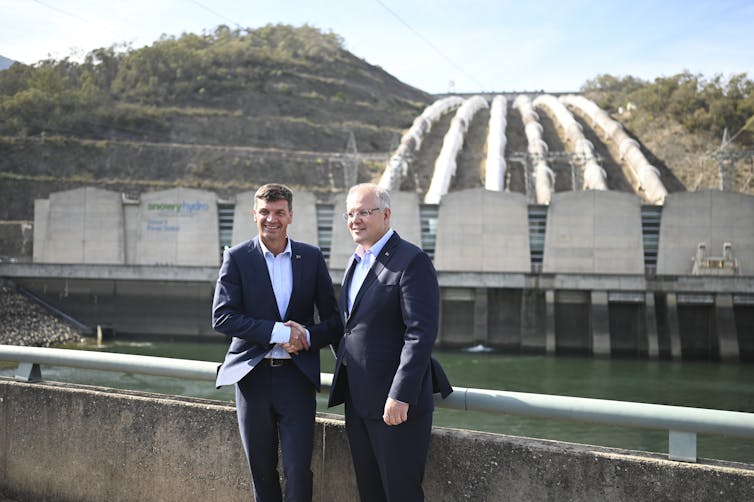Double trouble: this plucky little fish survived Black Summer, but there's worse to come
- Written by Mark Lintermans, Associate professor, University of Canberra
This article is part of Flora, Fauna, Fire, a special project by The Conversation that launched this week. The project tracks the recovery of Australia’s native plants and animals after last summer’s bushfire tragedy. Explore the project here and read related articles here.
On a coastal holiday last summer, I was preoccupied. Bushfires were tearing through southeast Australia, and one in particular had me worried. Online maps showed it moving towards the last remaining population of a plucky little fish, the stocky galaxias.
I’ve worked in threatened fish conservation and management for more than 35 years, but this species is special to me.
The stocky galaxias was formally described as a new species in 2014. Its only known population lives in a short stretch of stream in Kosciuszko National Park in New South Wales. A single event could wipe them out.
On January 2 the bushfires forced my family and I to evacuate our holiday home. As we returned to Canberra, I was still worried. Fire maps showed the stocky’s stream virtually surrounded by fire.
A few days later, I prepared for an emergency rescue.
 Fire tore through south east Australia in January, threatening the stocky galaxias.
Victorian government
Fire tore through south east Australia in January, threatening the stocky galaxias.
Victorian government
In critical danger
The stocky galaxias is the monarch of its small stream; the only fish species present. I’ve been trying to protect the stocky galaxias before it was even formally recognised.
Over the last century or more, the species has seen off threats from predatory trout, storms, droughts and bushfires. Snowy 2.0 is the latest danger.
It’s listed as critically endangered in NSW and is being assessed for a federal threatened listing. Before the fires, there were probably no more than 1,000-2,000 adults left in the wild.
Read more: After the bushfires, we helped choose the animals and plants in most need. Here's how we did it
As the fires burned, I knew we had to move quickly. I wanted to collect up to 200 stocky galaxias and take them away for safekeeping.
Rainfall after bushfires is major threat to fish, because it washes ash and sediment into streams. Storms were forecast for the afternoon of January 15. So early that morning, myself and two colleagues, escorted by two staff from the NSW National Parks and Wildlife Service, drove to the stocky galaxias stream.
A colleague and I waded in and began electrofishing. This involved passing an electrical current through water, stunning fish momentarily so we could catch them.
 The author and his colleagues used electrofishing to catch the fish.
Mark Lintermans
The author and his colleagues used electrofishing to catch the fish.
Mark Lintermans
After 45 minutes we’d collected 68 healthy stocky galaxias. Woohoo! Further downstream we collected 74 more. By now, fire burned along the stream edge. We packed the fish into drums in the back of my car and drove out.
We headed to the NSW Department of Primary Industries’ trout hatchery at Jindabyne, where we measured each fish and took a genetic sample. I felt immensely relieved and satisfied that we’d potentially saved a species from extinction.
The fish have been thriving in the hatchery building. Stocky galaxias have never been kept in captivity before, but our years of field work told us the temperatures they encountered in the wild, so holding tanks could be set up appropriately.
Read more: Conservation scientists are grieving after the bushfires -- but we must not give up
Back to the stream
The captive fish can be used for breeding, but the species has never been captive-bred before and this is not a trivial task.
When they’re reintroduced to the wild, the sites must be free of trout, and other invasive fish like climbing galaxias. Natural or artificial barriers should be in place to prevent invasive fish invasion.
In late March I finally got back to the stocky galaxias’ stream to see whether they’d survived. At the lower stretch of its habitat, the fire was not severe and the stream habitat looked good, with only a small amount of ash and sediment.
Upstream, the fire had been more severe. At the edge of the stream, heath was razed and patches of sphagnum moss were burnt. Again, sediment in the stream was not too abundant. But fish numbers were lower than normal, suggesting some there had not survived.
 Stocky Galaxias live in a short stretch of a single stream.
Credit to come
Stocky Galaxias live in a short stretch of a single stream.
Credit to come
The fight’s not over
The stocky galaxias species might have survived yet another peril, but the battle isn’t over.
Feral horse numbers in Kosciuszko National Park have increased dramatically in the last decade. They’ve degraded the banks of the stocky galaxias’ stream, making it wider and shallower and filling sections with fine sediment. This smothers the fish’s food resources, spawning sites and eggs.
Before the fires, plans were already afoot to fence off much of the stocky galaxias habitat to keep horses out. Fire damage to the park has delayed construction until early 2021.
Read more: Snowy 2.0 threatens to pollute our rivers and wipe out native fish
The biggest long-term threat to the species is the Snowy 2.0 pumped hydro development. It threatens to transfer an invasive native fish, the climbing galaxias, to within reach of stocky galaxias habitat. There, it would compete for food with, and prey on, stocky galaxias – probably pushing it into extinction.
Despite this risk, in May this year the NSW government approved the Snowy 2.0 expansion, with approval conditions that I believe fail to adequately protect the stocky galaxias population. The project has also received federal approval.
 Energy Minister Angus Taylor, left, and Prime Minister Scott Morrison, at the Snowy Hydro scheme.
Lukas Coch/AAP
Energy Minister Angus Taylor, left, and Prime Minister Scott Morrison, at the Snowy Hydro scheme.
Lukas Coch/AAP
Future in the balance
The stocky galaxias is unique and irreplaceable. I want my grandchildren to be able to show their grandchildren this little Aussie battler thriving in the wild.
The damage wrought by Snowy 2.0 may not be apparent for several decades. By then many politicians and bureaucrats now deciding the future of the stocky galaxias will be gone, as will I.
But 2020 will go down in history as the year the species was saved from fire, then condemned to possible extinction.
Authors: Mark Lintermans, Associate professor, University of Canberra





